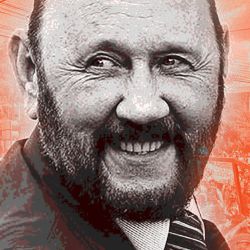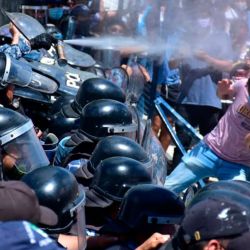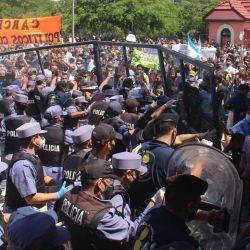Last year, on the evening of March 19, President Alberto Fernández declared a strict ASPO (aislamiento social, preventivo y obligatorio) quarantine order nationwide due to the Covid-19 pandemic, placing the handling of sanitary policies at the discretion of the provinces. In the course of the following year, the measures were relaxed throughout federal territory, save in Formosa. The provincial government maintained restrictive measures even without any positive cases of Covid-19 having been detected. By mid-2020 only two provinces had yet to confirm a case: one was Catamarca, the other Formosa.
The province maintained its sanitary status without viral circulation for several months via administered entry into Formosa, which every person had to request, then await their turn. Once inside, an obligatory quarantine followed (lasting 14 days or until a negative test result) in preventive centres in schools, sports clubs and other state premises. The system began to break down when the demand for entry exceeded the capacity of accommodation. Over 7,000 people remained stranded outside the province, many of them penniless and/or with nowhere to sleep. Simultaneously, accusations of irregularities started emerging which ended up in class actions for human rights violations.
Dominated
Zunilda Gómez, 33, was three months pregnant with her fourth child when last December 19 the police took her family from their dwelling in Clorinda (Formosa’s second-largest city, 80 kilometres from the provincial capital), according to an Inter-American Court of Human Rights report compiling different denunciations. The authorities locked up Gómez and her three children (aged 12, eight and five) in a hotel room. On January 5, Gómez began to haemorrhage and asked for help. In desperation, she asked her daughter to climb out of the window to find help.
One hour later the police transferred Gómez to a hospital, leaving her children locked up in the hotel room until the next day. Gómez suffered a miscarriage. Her husband, who had been transferred to an isolation centre 120 kilometres away after testing positive, found out about the loss of the pregnancy when a relative called him.
According to a report from the Human Rights Watch NGo, Formosa adopted abusive measures in its response to Covid-19. The police raided neighbourhoods where people testing positive lived, forcibly removing those suspected of contagion, even without any proof to confirm that suspicion and sometimes not giving them any time to pack anything.
The testimony compiled by the organisation reflects situations of uncertainty and desperation, like the case of a 71-year-old woman who fell in the bathroom of an isolation centre, breaking her hip. The authorities took six hours to take her to hospital, according to a family member. Meanwhile, dozens of desperate people chained up at the Estadio Cincuentenario indoor arena almost set fire to their mattresses in protest.
At the same time over 7,000 people, mostly from Formosa, remained stranded outside the frontiers, hoping for their reopening to permit a return home. Some had to camp up to six months alongside the road, until a judge ordered more flexible entry conditions for residents.
The restrictive measures implemented by the provincial government for 11 months through to last February seeking to halt the contagion became a national scandal.
The Johns Hopkins University centres for public health, human rights and humanitarian medicine, Amnesty International, the Inter-American Court of Human Rights and Argentina’s own Supreme Court defined the situation in Formosa as featuring clear human rights violations with the spotlight fully on the paradoxical figure of Governor Gildo Insfrán, a man who has been at the provincial helm for 33 years (25 as governor and eight as lieutenant-governor) and who has governed as an autocrat, as if he had full permission from his people.
Like no other provincial leader in Argentina or the rest of the continent, Insfrán has managed to dominate the democratic mechanisms of his territory to the degree of winning nine consecutive elections. Worldwide there are only 12 incumbent heads of state who have been in power for longer periods than his at the helm of his province.
How has Insfrán managed to stay in power for so long? Like other caudillos of Latin American history, Insfrán has managed to monopolise provincial politics. Politically astute, with an almost chameleon-like capacity for allying with other politicians, a popular discourse with local colour and some tailor-made provincial norms have made him the only politician in Argentina (and Latin America) to govern for so many years on the trot.
People’s politician
According to Argentina’s most recent national census, Formosa has 530,162 inhabitants, representing 1.3 percent of the national electorate.
“There is nothing extraordinary about this land. The northeastern province of Formosa is flat with vegetation which fluctuates between the discreet green of the fertile zones to the dry fields of the arid. There are no lakes, nor mountains nor waterfalls nor exotic animals. Just tropical heat mixed with dust in one of the poorest regions of the country,” wrote journalist Leila Guerriero about the territory.
Into that hot and difficult soil was born Gildo Insfrán on January 19, 1951, in Laguna Blanca, the youngest of three sons in a Paraguayan immigrant family.
His father, a veteran of the 1932-1935 Chaco War, died when Gildo was a child and his oldest brother Miguel, (‘Joni’ to his friends) had to take charge of the family household. Among other things, he funded the future governor’s university studies in Corrientes, where he graduated as a veterinary surgeon. Insfrán views his older brother as a father, referring to him before making any decision, according to family and friends.
At the Universidad Nacional del Nordeste, Gildo Insfrán began his political militancy. First he flirted with Maoism in the Revolutionary Communist Party (PRC, in its Spanish acronym) but he rapidly turned Peronist, joining the Justicialist Party (PJ). When democracy returned to Argentina in 1983, he ran for provincial deputy representing Laguna Blanca and his days as a vet were over.
That year the presidential triumph of Raúl Alfonsín renewed the democratic spirit of a society devastated by the legacy of the military dictatorship since 1976. Argentina returned to the ballot-box and that implied, among other things, weaving electoral alliances. In the north a triumvirate began to be created that persists until today: Vicente Joga, Floro Bogado and Gildo Insfrán.
In the 1983 provincial elections the young blue-eyed vet won his provincial legislature seat and during his term dedicated himself to noiselessly exploring the province from end to end.
“He was down-to-earth, somebody who stopped to talk to ordinary people, somebody who spoke to you, somebody you could touch, which didn’t happen with Joga who was an introvert with no contact with the people,” explained an official close to the governor, who has accompanied him from the start.
Little by little, his charm began to spread. ‘Tío Gildo’ (“Uncle Gildo”) was a nickname which started years later with the party youth. He liked to drive his van every Sunday through the provincial capital, stop at corners and talk to people. He even has a customary drive down the esplanade on the banks of the River Paraguay, his greatest work, his pride and the city’s main attraction. Always in the front seat next to the driver, Insfrán smiles. He hardly cares if he receives compliments or protests, he always smiles and waves before moving on.
Almost as if he were a saint, portraits of his image are all over public offices and family homes, where it shares pagan altars with the figures of Juan Domingo Perón and Evita.
“He gave us everything when we had nothing. All of a sudden the children had new sneakers, smocks and school utensils to start classes. You could toast Christmas with cider, a pan dulce and a letter of greetings from the governor,” recounts a man from the San Agustín neighbourhood in the provincial capital.
Affection and authoritarianism
In his Congressional office, Senate Minority Leader Luis Naidenoff (Radical-Formosa) maintains that one of the factors sustaining Insfrán in power is that affectionate bond he has created with the people, “consolidating a leadership of affectionate authoritarianism and a level of submission and dependence on the state.”
But Insfrán has also created an “institutional cocktail including the ‘ley de lemas’ which favours the government,” adds the opposition leader.
The ley de lemas (or holding primaries and elections simultaneously) applies today in Formosa (for legislative and municipal elections), Misiones and Santa Cruz.
According to Naidenoff, “the opposition has not succeeded in all these years in producing an alternative with the capacity to catch on in society.” He understands that the rupture arising from the pandemic has to do with generational change: “A new generation with an integral outlook and the rebellious spirit to say ‘This doesn’t work any more.’”
A senator since 2005, Naidenoff affirmed that only twice in his life has he spoken with the governor. “Once for a personal motive,” after his wife and child perished from carbon monoxide inhalation in 2018; and the other when Insfrán summoned him to his office following the Covid repression for a dialogue over possible solutions to the conflict occasioned by the restrictive measures imposed by the government. The first meeting between these politicians was thus far from political, but in reality the encounter of two men sharing the tragedy of losing a child.
The governor’s approach to the people has materialised via the creation of the ‘Por nuestra gente todo’ (“Everything for our people”) provincial programme, a series of neighbourhood activities whereby all areas of government are transferred on the spot in order to deliver different services every Saturday, including medical attention of different specialties, talks regarding the prevention of diseases such as dengue, the vaccination of pets, sporting activities and the announcement or inauguration of public works. These events bringing together officials with the people generally draw in hundreds of persons.
Apart from the governor, other government members, the authorities of the security forces, the heads of medical and educational institutions and militants all turn out to support the “conductor,” as the latter call the governor.
Insfrán makes his moves astutely, like somebody who knows what he’s doing. That’s how he resisted the media bombardment during the rebellion of his “fellow Formosans.”
The governor has managed to build a wall, both materially and symbolically, around his personal life. He has never lived in the gubernatorial residence and the only image of his home anybody can find today, ever since he decided to move his house downtown, is an enormous brown wall.
This hermetic quality is his virtue and political capital. Nobody has ever managed to put him on the spot regarding his private life and rumours which have him vacationing in the Maldives with a presumed girlfriend or his alleged custom of giving away imported handbags are just that, rumours which have never acquired the force of truth. Ever since he ended his marriage to the mother of his children, Teresa Baldús, he has not appeared with another partner.
His daily wardrobe is discreet, a suit for some occasions, or jeans with sports shirts, sometimes colourful and mostly Lacoste. Not much more than that.
Insfrán is not the only politician in his family. His brother is also a deputy, as is his daughter, with a niece as his Legal and Technical secretary and another niece as a city councillor.
‘The model’
“Gildo Insfrán has very intelligently started to work on the Formosans,” taking advantage of their resentment of the Federal Capital, affirm interviewees who prefer to withhold their names.
This vision materialises in the publication of “Modelo Formoseño,” a manual of doctrine distributed among his militants as a sacred torch to light the way. Anybody criticising his policies is considered a “traitor to The Model.” The document emphasises the vindication of social rights, as befits the Peronist welfare state – a doctrine fervently followed by Insfrán – within an excessive personalism (the name of Gildo appears 269 times) and a painstakingly crafted Formosan identity.
“Insfrán has tried to impose the idea that we are a bilingual province speaking both Spanish and Guaraní but you’re not going to find a person who demonstrates that for him,” says Gabriel Hernández, Formosa City mayor between 1999 and 2003.
Hernández agrees with the theory of the governor’s resentment towards the citizens of Buenos Aires and the other big cities. Like Argentina itself, Formosa is a territory which was populated by the children of immigrants and the indigenous peoples.
In one of his most recent public appearances, displaying his antipathy towards large cities, Insfrán dubbed as “drones” the inhabitants of the City of Buenos Aires.
“The porteños, who do not know how to plant lettuce, want to come and tell us what to do. Drones who live off the effort and work of the entire Argentine people,” the governor lashed out.
Hernández affirms that his time as mayor was “traumatic” because after Insfrán’s mayoral candidate lost out, the governor opted to slash his funds and delay paying municipal salaries, thus creating an unsustainable working climate.
The ex-mayor is suing the governor, with litigation now in the Supreme Court, over the statements of an anonymous radio listener, who accused Insfrán of being involved in the death of his son while speaking to Hernández's show.
If the governor owes his long tenure to anything, it is to constitutional reform. In 1987, his political style and capacity to approach Formosans drew the attention of then-governor Vicente Joga. Insfrán knew how to take advantage of that opportunity and ally himself with the top figures of local politics. He did not hesitate when the so-called ‘Lion of the North’ invited him to be his running-mate for Lieutenant-Governor.
Once elected, Joga pushed forward his plan with a 1991 constitutional reform permitting only a single re-election at a time, thanks to which he won a new term that same year. Like the rest of the country, Formosa was undergoing a profound economic crisis and Insfrán was picked by Joga himself to be his successor and thus the visible face for the austerity which had to be imposed on the province.
The mission entrusted to Insfrán was simple: govern the province during the years of economic cuts, resist the pressures of a frustrated society and then step back to make way for Joga again. But the latter did not take heed of the contacts made by his candidate during his years as legislator. What Joga thought was a masterstroke was in reality his political downfall.
Insfrán won the elections according to plan in 1995 and his first promise as governor was “to sacrifice myself for the common good, being at the side of those who need me without asking who they are. But make no mistake, do not think that this province will grow and transform itself because it needs the responsible work of its children,” he warned.
Right from the start he sent a clear message to the opposition: “The winner governs and the loser supports, as [Radical Ricardo] Balbín once said,” in reference to the opposition politicians who were already beginning to show their distaste for his arrival in power.
His supporters say that he is “true to his own” and so he demonstrates it by having the same old cabinet all the time. Gildo did not reach government alone and he has his unconditional aides: Armando Felipe ‘Papacito’ Cabrera, Justicialist Party trustee and Legislature Speaker, and Cabinet Chief Antonio ‘Pomelo’ Ferreira. “With them he came and with them he’ll go,” they affirm from his entourage.
During his term he made the power constructed by his predecessor his own. Soon, Insfrán was airbrushing Joga out of provincial history. In 1999, Gildo finally broke with his former political mentor, launching his own re-election bid. Joga vanished from the political scenario.
Once in charge, the governor knew how to make alliances with prominent national politicians (another of his great talents), which permitted him the funds and political capital to develop his model and dig in. In 1998, he became the Formosan link for then-president Carlos Menem, who was seeking a constitutional reform to run for a third term. His support was a double-edged sword – consolidating his alliances with the national government while preparing his discourse for his own re-election (at that time also unconstitutional). Menem’s aspiration was frustrated the following year. But Insfrán knew how to ride the defeat of his national ally.
From Menem to Kirchner
An ex-official belonging to the governor’s inner circle relates that during the 2001 crisis, Insfrán (already firmly present within the Justicialist Party) installed himself in Buenos Aires with the intention of helping to find a peaceful way out of conflict, converting himself into a key player towards Eduardo Duhalde becoming caretaker president.
When the elections were brought ahead for 2003, both new and old names appeared for the presidency with the promise of bringing the calm which the people so needed, including one with a political style without frills or protocol – Néstor Carlos Kirchner, until then an unknown politician from a minor southern province.
Insfrán spotted Kirchner’s potential and decided to back his candidacy, even against ex-president Menem, his old ally. Whether by chance or because he made a politically astute call, his gamble turned out well.
On May 28, 2003, only three days after his inauguration, Kirchner arrived in Formosa and signed a Historic Reparations Act signifying the payment of huge sums of money for public works or, as the state decided to call it, “redress for so many decades of being sidelined.”
The proposal fitted in perfectly with the Modelo Formoseño claims of the province being historically forgotten by the national capital and, thanks to those funds, Insfrán filled Formosa with schools, hospitals, roads and sports centres, the latter with his watermark: blue roofs, which since then have characterised all provincial public works. The historic reparations were beyond doubt his biggest hit.
The successful bet on Kirchner gave him the political capital to go ahead with a new constitutional reform in 2003, opening the door to indefinite re-election, which duly followed: in 2007, 2011, 2015 and 2019.
One of the few surviving orthodox Peronists and a leading PJ governor, Insfrán has made a slogan out of the concept “social justice,” replaying it as a major theme at every public appearance. That adhesion to the most basic ideas of Peronism meant a problem when his friend Kirchner died and then president Cristina Fernández de Kirchner took control of the party, becoming the political leader of the movement. While Néstor was his friend and an ideal ally, the eruption of his widow was a problem, with a progressive agenda replacing the “Peronism of Perón.”
In those years Gildo saw his leadership threatened by the advance of La Cámpora. He rapidly created AFUS (Agrupación Formosa Unidas y Solidaria) to gather provincial youth in order to leave the Kirchnerite grouping without a foothold. This translated into tension with Cristina Fernández de Kirchner.
Some have confessed to repenting the controversial provincial constitutional reform such as Adrián Bogado, a former provincial deputy and the son of the 1983-1987 governor and Insfrán’s lieutenant-governor until his death in 2017, Floro Bogado.
Adrián Bogado said bluntly: “It weighs on me having voted for that reform.” But at the time he raised his hand in a session attended only by government deputies who changed their province forever by giving Insfrán a free hand for eternal power.
A dissident Peronist today, Bogado maintains that Gildo lost the essence of Peronist ideas some time ago. He trusts in the rupture of the status quo during the pandemic having political consequences, asserting without the slightest doubt: “We’re facing the end of this government.”
In the term beginning in 2003, Insfrán consolidated his political hegemony, winning the 2007 elections with 76 percent, his best ever tally. He also faced charges of corruption, the most important coming when businessman Alejandro Vandenbroele of Ciccone money-printing scandal notoriety testified that he had bribed Insfrán in order to obtain a contract for advising the province on its handling of debt. The curious thing about this case is that some of the defendants, including former vice-president Amado Boudou, have already been convicted but the investigation of Insfrán, his former Economy minister Inés Lotto de Vecchietti, Jorge Ubaldo Melchor (former head of Fonfipro) and Formosa Provincial Bank governor Martín Cortés (whose coffers received the money) has not advanced in court.
Dependence
Another factor helping to consolidate Gildo’s power is the province’s peculiar productive model. At the macroeconomic level, Formosa’s main source of income is federal revenue-sharing.
Political scientist Carlos Gervasoni, who heads the research department at the Universidad Torcuato Di Tella, maintains that Insfrán’s lengthy spell in power stems from the structure of Argentine federalism, which confers a certain degree of autonomy on the provinces.
“Formosa’s own tax intake is minimal in relation to the federal revenue-sharing received from the central government, which accounts for almost 97 percent of its funding,” explains Gervasoni, thus triggering “great dependence.” In his opinion, “most people, including business companies and the media, depend on the state. That empowers the provincial government.”
Nationwide Formosa is the province with the least registered private-sector employees, only 27,444, and the least exports: US$21.8 million in 2016. It is topped only by Catamarca for the most lopsided ratio between public and private employees: 167 public for every 100 private, according to the most recent Interior Ministry data from the year 2017.
“The question is what the provincial government spends this money on. If it went to productive investments like education, health, infrastructure, roads, Internet, science and technology, ports and airports permitting exports to Brazil or Paraguay or wherever, the public and private sectors in Formosa should be converging bit by bit, which is what economic theory tells us. The problem is that all those jobs Formosa should be offering to the private sector are taken by the public sector,” explains Gervansoni.
Last year Formosa supplied less than 0.1 percent of total national exports according to the OPEX (Origen Provincial de las Exportaciones) report of the INDEC national statistics bureau.
“When everybody depends on the provincial state, the opposition stands very little chance,” affirms Gervasoni.
Poverty is a deliberate policy, according to opposition voices.
“Until 30 years ago Formosa was productively important, generating income and jobs, especially in rural zones. It was a sustainable province. Little or nothing of that is left. A huge majority live off public employment or social plans,” said Ricardo Buryaile, who was agriculture minister during the Mauricio Macri government and is now a Radical deputy for Formosa, in an interview.
This definition is one of the possible answers explaining Insfrán’s permanence in power. Despite seeming compliance with the basic principles of democracy, such as elections at regular intervals and a Legislature which functions with the participation of an opposition, the latter cannot count on government funds for its campaign with scant possibility of giving electoral battle on equal terms.
What has worked very well for the governor has not done so for the people of Formosa, which continues to be one of Argentina’s poorest provinces. According to the latest data from INDEC, in the first half of 2020 42.4 percent of the people in the provincial capital were below the poverty line and 8.8 percent destitute, with poverty two points up as against the same period in 2019.
Formosa is also only topped by the province of Corrientes for child mortality with 11.3 deaths for every 1,000 births, according to the latest available data (2018), while it tops the national ranking of maternal childbirth mortality with 14.4 deaths per 10,000 births.
Its gross domestic product represents less than one percent of the national figures, even including the transfers from the national government, which provide little incentive to improve provincial productivity and thus collect more taxes. As for private employment, 5.2 companies are registered for every 1,000 inhabitants when the national average is 14.5, according to the latest data published by the Labour Ministry dating back to 2017.
An exhausted model
Just like the pandemic, the political crisis took the Formosa government by surprise. The strict measures imposed by the governor irritated the population like nothing before. On March 5, 2021, the people spontaneously went out on the streets for the first time to protest. Insfrán replied with police brutality, including rubber bullets and tear gas (already expired in 1995) being fired directly at demonstrators.
Journalist Julieta González was beaten up and arrested while covering the protest. She reported: “The police bashed in a woman’s head for wanting to hang a poster on a policeman’s shield. That detonated violence and added much more popular discontent than the subsequent repression.” The reporter was detained incommunicado for seven hours, along with other women.
Until then Insfrán had never needed to resort to direct violence against the citizenry. His complex fabric of power worked otherwise, being silently and meticulously woven from inside, far removed from national newsflashes.
But the pandemic placed him against the ropes. After the protests and the subsequent denunciations of repression, acceptance of the governor was hurt. According to a survey last March by Acierto consultants, Insfrán has a negative image of 49.7 percent nationwide and a positive of only 13.8 percent.
In the PASO primaries, Formosa’s Peronists suffered an unprecedented loss of votes, prompting the governor to centre his efforts on turning round the voting for this month’s midterms. For the first time, Insfrán faces the possibility of losing a seat in the national Congress and several in the local Legislature, which would compromise the automatic majority permitting him to approve budgets and name judges all these years without needing any agreement with opposition parties.
“The problem is that what once worked no longer does,” affirms one of his territorial militants,critical of strategy but loyal to the government, for whom “when you’ve been on top for so many years, you become removed from the people and cannot read clearly their true needs.”
Yet many still defend him. President Alberto Fernández has not ceased publicly supporting the Formosa governor and in May last year even affirmed that he was his “friend” and that Insfrán’s restrictive measures “the model to follow” for the post-pandemic economy.
There are still two years left in the term of the eternal governor. By the 2023 elections he will have been heading the province for 28 of his 72 years. A popularity hit by denunciations of abuses in his handling of a pandemic which has left more than 62,000 infected and 1,218 dead in the region over which he rules.
After 33 years and with one week to go until midterms which could change the course of his government, the scenario is uncertain. It is impossible to determine whether the pandemic, which was also an ideal scenario for exposing the networks woven by a governor who hangs on without alternation, will also deliver grave political consequences for Formosa’s caudillo.



























Comments